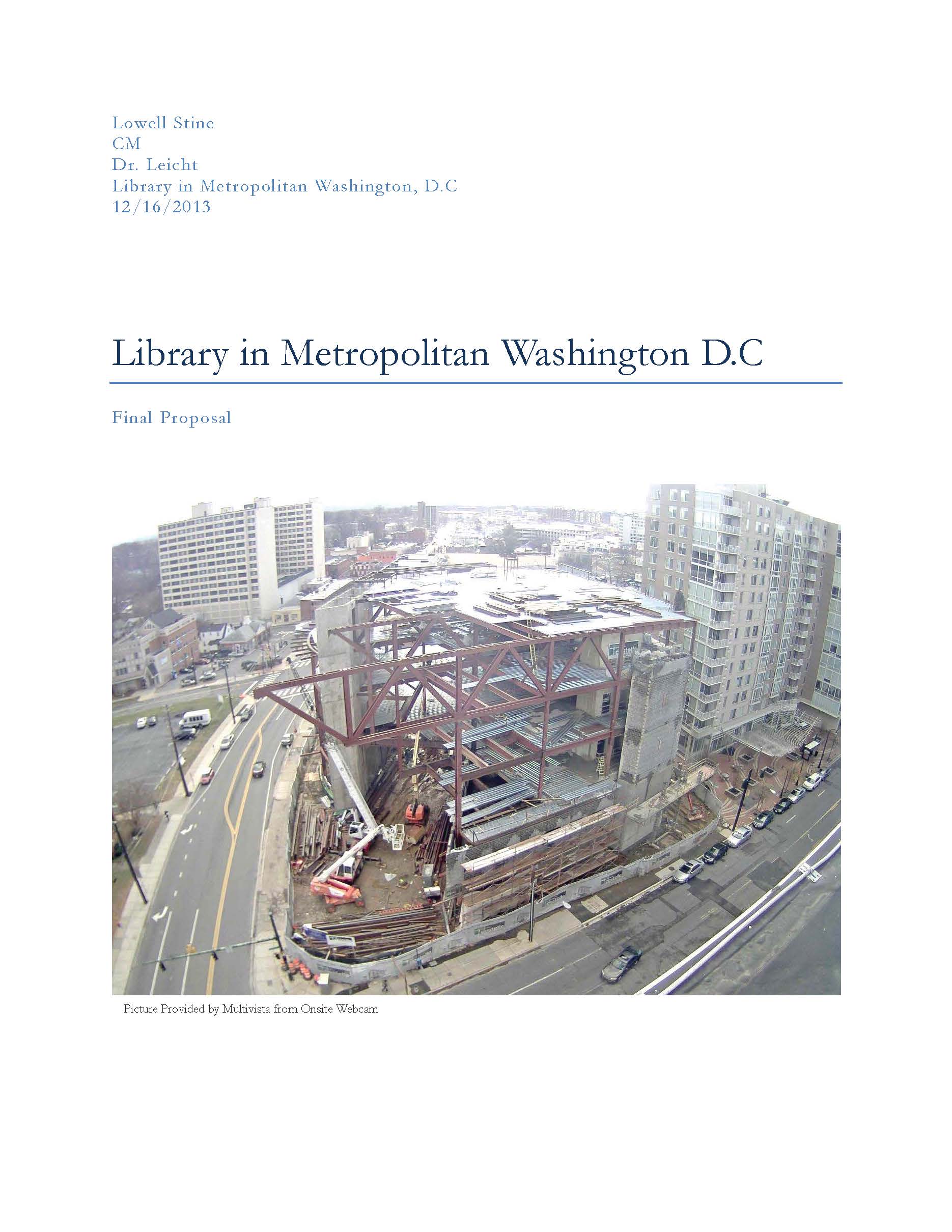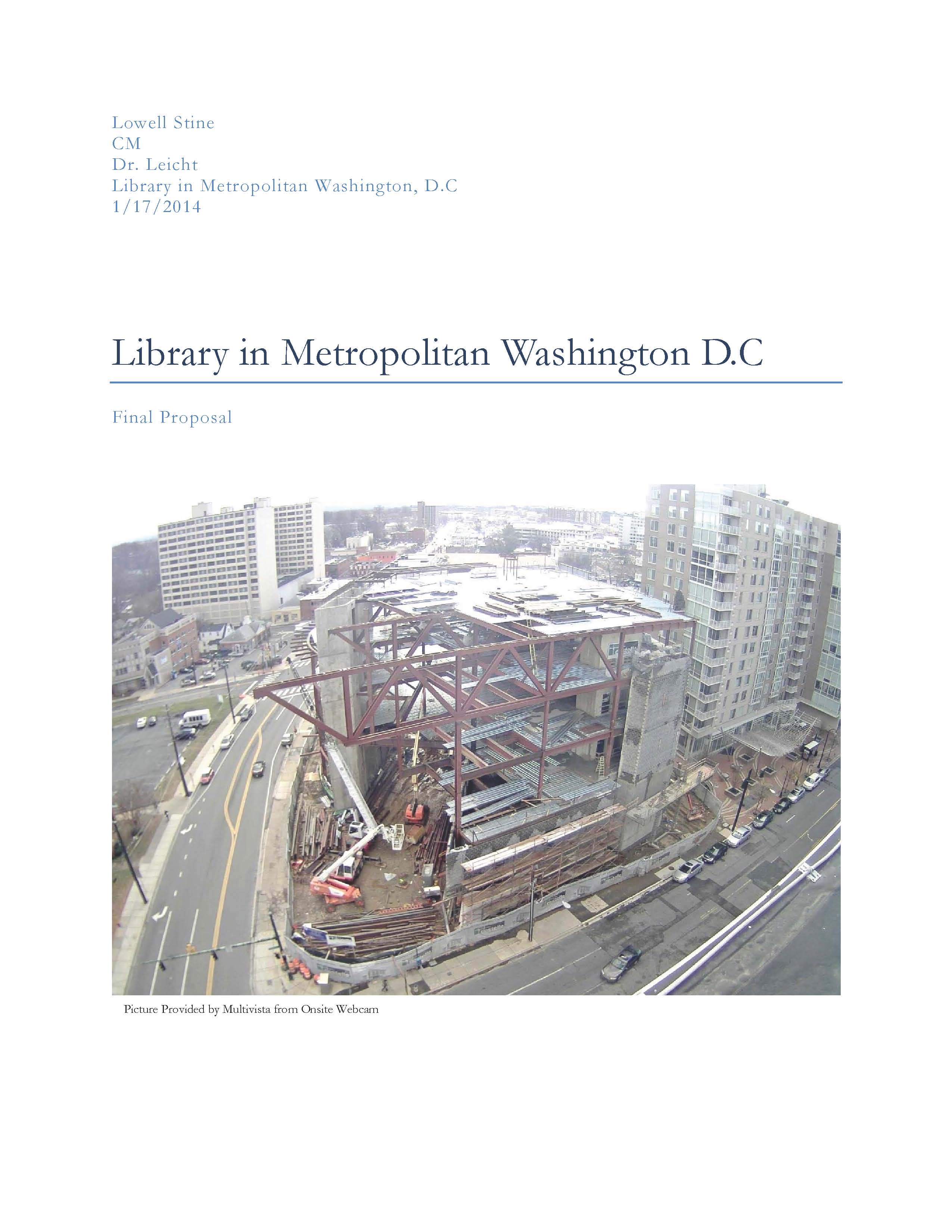Lowell Stine |
Construction Option |
2013-2014 |
|
Library In Metropolitan Washington D.C. |
Thesis Proposal |
|
|
|
|
Thesis Proposal |
|
To view and/or download a PDF of the Thesis Proposals click the proposal pictures above. |
|
| |
|
Research Analysis #1 |
To start off the proposal, a research topic is introduced in which includes early involvement of specialty contractors. This analysis looks at the direct benefits both in preconstruction and during construction of getting design related feedback from the contractors who will be installing the work. Trades that will be analyzed in this topic include caisson installation, structural erection, the IPEC and/or MEP trades, and the curtain wall. Solutions will involve some combination of design-build contracts and design assist contracts. Items to be considered and researched during this analysis will be owner involvement, industry member interviews with Truland and other design-build firms, other scopes that would be benefited, when each trade will be brought on-board, what each trades involvement should or shouldn't be, and cases studies that used this type of building delivery system, such as the South Halls Renovation. |
| |
|
Analysis #2 |
An alternative structural steel erection sequence will be determined in the second topic. A 19 zone steel erection is currently being used on the project and is creating delays because of inconsistency of productivity. A variety of alternative erection sequences will be analyzed in the following criteria; affects on cost, schedule, site logistics, quality control, onsite safety, and other constructability related issues. Resources that can be used to design a new sequencing plan include structural faculty members, structural classes previously taken, and a 4-D structural model that will be created. A structural breath will be included in this topic, which will determine if the structural sequence is structural stable and if not, then redesigning it so it is. |
| |
|
Analysis #3 |
It is believed that the IPEC may not be the proper selection of a mechanical room for this project because of the current delivery method. While the IPEC system is a great idea in concept, it may have constructability issues and project delivery system issues in this project, which caused delays in procurement and coordination. This topic will weigh the benefits of the IPEC over a traditional mechanical penthouse or mechanical rooms in the building. The creation of a decision matrix will determine the best system to use on this project. A mechanical breath will result from this analysis because if the mechanical equipment gets moved from the roof, then fans and pumps will need to be resized to ensure the system will function correctly. |
| |
|
Analysis #4 |
During the caisson installation a delay emerged because onsite refabricating of the rebar cages were required. The fourth topic looks at ways rebar cages can be fabricated effectively without running into these problems. Three types of slices will be reviewed for strength, durability, cost, constructability, and productivity. Fully prefabricated cages, site built cages and prefabricated 5 feet cage sections will also be studied. How the cages are maneuvered can save crane time on the project. Contacts including Ray Sowers and Walter Schneider will be collaborated with to gain farther insight on this topic. Two case studies will also be used to compare fabrications methods with methods used on the library project. |
| |
|
Structural Breadth |
A structural breath will be incorporated in Analysis Topic #2 for the structural steel erection sequence redesign that is outside of the construction management realm. This analysis lends itself to a structural breath because in reevaluating the sequence and methods used to erect steel for this project, multiple structural calculations will be required. In the option to assemble the cantilevered portion of the building on the ground and rise it into place, this breath will include designing lifting points in the structure to ensure the structural stability of the frame during lifting and calculate the required lifting capacity of the crane or jacks needed. If shoring is to be used to support the cantilever, then this breath topic will include designing the shoring system along with its support system. As with any unknown structural erection method, similar structural stability calculations will be performed to check the feasibility of any and all options, like the ones mentioned above. In any case, the top priority will always be safety of the workers, general public, future users, and all involved in the project. This breath topic will strengthen Analysis Topic #2, provide a more in-depth analysis, and take into account the structural reasoning of selecting a specific method. |
| |
|
Acoustical Breadth |
An acoustical breadth topic will be included in Analysis Topic # 3 that involves minor acoustical calculations to compare the sound and vibrations produced by an IPEC as compared to the mechanical penthouse option. This acoustical breadth analysis will tie nicely into past knowledge obtained in AE 309 (Architectural Acoustics). An acoustical study is particularly important for this building because the area designated for the IPEC or mechanical room will lie directly above the library, meeting space, and library administration offices. It is essential that noise and vibrations be minimized in these spaces. If the noise and vibrations produced from a mechanical penthouse are substantially more than the IPEC, then this could be the driving factor for keeping the IPEC design. The goal of this acoustical study is to ensure that the acoustical environment of the library and surrounding spaces are not compromised. A minimum allowable decibel level will be specified for the space under the mechanical space using references from AE 309. Then the estimated decibel level will be calculated in the mechanical space using manufacturer's specifications and equipment information sheets. Each type of mechanical room's floor and the library ceiling's transmission loss will then be determined or estimated. With the above information the decibel level in the library can be estimated and compared to the previously determined maximum allowable level. If this decibel threshold is not met in either one of the mechanical room options, then the assembly between the mechanical equipment and the library space will be altered to improve its' acoustical performance. However, the cost and schedule impact associated with this change will be calculated and added into the comparison already being performed in Analysis Topic #3 to determine which mechanical room option is the most feasible for this building. |
| |
|
User Note: While great efforts have been taken to provide accurate and complete information on the
pages of CPEP, please be aware that the information contained herewith is considered a work in in progress
for this thesis project. Modifications and changes related to the original building designs and
construction methodologies for this senior thesis project are solely the interpretation of Lowell Stine. Changes and discrepancies in no way imply that the original design contained errors or was
flawed. Differing assumptions, code references, requirements, and methodologies have been
incorporated into this thesis project; therefore, investigation results may vary from the original
design. |
|
|
This page was last updated on 1/20/2014, by Lowell Stine and is hosted by the AE Department
©2013
|
|
.jpg)

